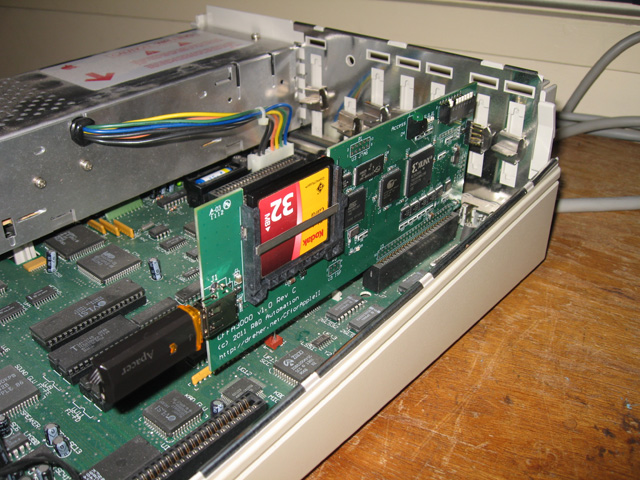The CFFA3000: The ultimate Apple IIGS companion
Introduction
One classic computer surprise to me was how much I've enjoyed playing with my new Apple IIGS, the forgotten child of the Apple II line. I like the clear RGB screen, the Mac-like GS/OS and the compatibility with older software. The only thing I don't (or rather didn't) like was the inconvenience of my floppy-only system. The computer begged for a hard disk, where loading GS/OS software would be a breeze rather than a slow chug off a 3.5 inch floppy.
One option was to get a good SCSI card and a compatible external drive. I had the latter but not the former. I was mulling over this option when I was made aware of the CFFA3000 card, a CF/USB flash-tech solution which provided disk support from disk images. This sounded ideal so I made the order!
What the CFFA3000 does
In a nutshell the card acts as a super disk controller/management system but for disk images rather than real disks. The images are accessed from a COMPACTFlash (CF) card and/or a USB pen drive plugged into the card. These storage devices can be removed and plugged into a desktop computer for disk image manipulation and/or acquisition, then placed back in the card. It's like having a stack of floppies and hard drives instantly available!
If the card is configured correctly, it doesn't interfere with existing drives. Finally, firmware in the card allows for the creation of blank images and the imaging of disks, which is a great way to capture that old floppy collection.
Impressions
At the time of purchase the card was very popular and I had to go on a waiting list for a few weeks. However soon it was sitting in my postal box. It was well-packaged in an antistatic bag accompanied by a CD-ROM containing the manual and other material. The device appeared well-engineered and professionally put together.

Figure 1. The CFFA3000 installed. I could have used either a CF card or USB stick. I elected to use both!
It took me a little bit of time to figure out how to configure the card correctly. However, this was more my ignorance of Apple II/IIGS concepts (particularly the role of the slots) than any deficiency of the manual. In fact setting the card up taught me more about IIGS slots and how they work than I had gained just playing with the machine.
The card itself has two "Volumes". One is a DISK II area containing two virtual disk II drives (for 5.25 inch disk images). The other is a SMARTPOINT volume for 800k disk and hard disk images. Both volumes have to be mapped to a particular slot in the Apple II machines.
My Apple IIGS had real 5.25 inch and 3.5 inch drives attached so slots 5 and 6 were taken. I mapped the virtual DISK II to slot 4, and the Smartport to slot 7. The card itself resided in slot 7. With this arrangement everything worked. I created my own hard disk image by first creating a 32MB empty image then using the GS/OS setup disks to format it and install the OS. Using the IIGS control panel settings I found I could boot off the virtual floppies, boot off real floppies and boot off the virtual hard disk. I also imaged a few disks both from my attached 5.25 inch drive and the 3.5 inch one, and also used the card to make real disks from the disk images.
There were no problems with any of the above apart from a couple of exceptions. I did have a problem booting my Castle Wolfenstein 5.25 inch disk image. The program wouldn't start and instead threw me into the Apple machine language monitor? After some head scratching this was solved by altering a setting in the CFFA3000. I told it NOT to "Patch DOS RWTS for speed" (which was ON by default). Notes attached to that option did say it might be incompatible with some software as was indeed the case with Castle Wolfenstein.
The second problem concerned an autostart disk image of ZORK 1. Even though it was booting from the virtual disk II in slot 4, it caused my REAL 5.25 inch disk drive in slot 6 to activate and look for the software. I figured slot 6 must be hardwired into the boot sequence somewhere for this disk. Indeed, when I mapped the virtual drive onto slot 6 (and unplugging the real drive), Zork 1 loaded just fine.
Conclusion.
Great! I've got all my favourites loaded in two 32 MB hard disk images with loads of GS software on a USB pen drive AND a stack of floppy images on an old 32MB CF card salvaged from an old camera. Unless I want to show the IIGS off in its original configuration I never need to plug in drives again!
Was it worth it? Well, the CFFA3000 is pricey compared to some virtual disk solutions. However, considering the limited vertical market and features incorporated into the card, the price is not unreasonable. The device is well-engineered, easy to use and is compatible with standard drives so it doesn't degrade the complete vintage experience for those that still want it. It doesn't only replace drives, it can also supplement them.
I give it a big thumbs up!
Tez
24th October, 2012
| Tweet |